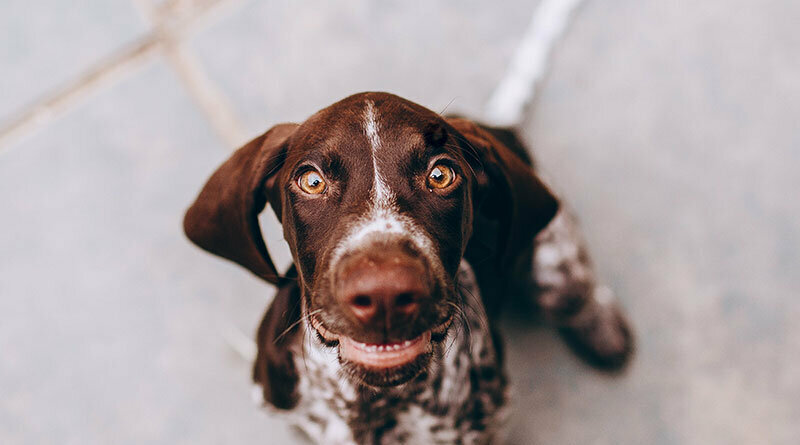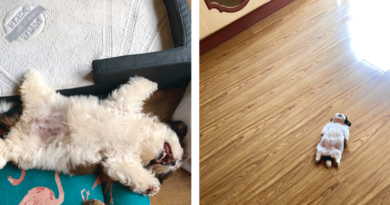Even Puppies Get the Point
Dogs’ ability to understand us and to respond to our attempts to communicate with them has long been considered a fundamental part of the close relationship we share. More than two decades ago, researchers first provided evidence that dogs can follow human pointing gestures.
Many studies have since shown that when humans point at one of a pair of identical objects to indicate the location of food, dogs respond by choosing the one that’s pointed at more often than we would expect by chance. This may sound like a simple ability, but perhaps that’s because it’s so simple for us. The idea that another species can also respond to our pointing is a big deal.
As happens with any meaningful discovery, this topic has been extensively debated. Questions about the behavior largely revolve around whether dogs learn what this gesture means because they spend so much time with us or whether they have a natural ability to understand that pointing is a way to direct their attention to something of interest.
For both practical and ethical reasons, this is a tricky thing to study. Most adult dogs have a lot of experience with humans. To raise dogs without such contact for the purposes of a scientific study would be cruel and totally unacceptable. It would also be futile, because such dogs would be so poorly socialized and so fearful that they would not be able to participate in studies. Puppies, however, are another matter.
GET THE BARK NEWSLETTER IN YOUR INBOX!
Sign up and get the answers to your questions.
In a recent study, researchers took advantage of the fact that young puppies have limited experience with people to explore their ability to respond to human pointing gestures. The 375 puppies who participated were between 7.3 and 10.4 weeks old (mean age, 8.4 weeks). The puppies were on loan from Canine Companions for Independence, a nonprofit group that provides assistance dogs to people with disabilities. The 203 females and 172 males came from 117 litters. Breed-wise, there were 98 Labrador Retrievers, 23 Golden Retrievers and 254 Golden Retriever/Labrador Retriever crosses.
In the study, the puppies had a choice between two containers, one of which had a piece of kibble in it. While one person held the puppy, another got the puppy’s attention and either pointed to and gazed at the container with the food reward or showed the puppy a marker (a small yellow block), then placed the marker next to the correct container. Based on the point gesture, the puppies chose correctly more than two-thirds of the time. They chose correctly nearly three-quarters of the time when the person communicated the location of the food by placing the marker.
In control trials, during which puppies were not directed and could presumably choose based on the odor of food, their choices had a 48.9 percent success rate—essentially random, and ever-so-slightly worse than you would expect based on chance alone. These trials showed that puppies weren’t finding the food by sniffing it out.
Multiple replications did not appear to improve the puppies’ performance. That suggests that they are not learning the task during the study. (They had either already learned the task despite being so young, or were able to do it without having to learn.) Previous studies with adult dogs—both pet dogs and assistance dogs—found similar success rates at the pointing task, and even greater success at the marker task.
Another aspect of this study explored the genetic basis for variation in dogs’ ability to succeed at the task of finding food based on human indications of its location. They found that 43 percent of the variation could be attributed to heritability, validating a long-held assumption that genetics are at play in canine social and cognitive abilities. This is an important finding. In order for selection to act on dogs’ ability to respond to human communication, as many theories related to domestication of dogs hold, there must be some genetic basis.
It’s critical to understand that even a natural ability can be subject to learning, so it’s not the case that dogs either have an innate ability or they must learn the skill. The idea that behavior is binary is extremely outdated. In fact, an influential study from 1967 in my field of ethology had the incendiary title “Ontogeny of an Instinct.” To understand why it was so incendiary, it’s essential to know that ontogeny means development.
The study was about changes in a behavior pattern considered instinctual: a gull chick pecking at a spot on an adult gull’s beak to elicit feeding. Such species-typical behavior patterns were considered to be inborn rather than learned. But in a series of studies, Jack P. Hailman, PhD, showed that learning occurred and that gull chicks improved their pecking accuracy with practice.
The idea that instinctive behavior was subject to improvement and that learning occurred in relation to such behaviors was revolutionary and changed the field considerably. Yet, here we are, more than 50 years later, still discussing whether behavior is instinctive or learned. It’s more complex than that, and we need to accept that learning can play a role even in behavior that is natural and prevalent in a species.
One possibility that must always be considered is that dogs are predisposed to learn the skill of following human gestures. That is, it may be easy and natural for them to learn to do so. In fact, it may be so easy and so natural that it would be hard to find dogs who haven’t already learned it. The current study provides evidence that even young puppies who have not had extensive experience with people can perform this task, and—as interesting and important—that there is a genetic basis for this behavior. However, it has not been demonstrated that dogs have this skill in the absence of any experience with humans.
The researchers say it fairly in their paper: “Collectively, our results demonstrate that dog social skills emerge robustly in early development and that variation in these traits is strongly influenced by genetic factors.”




